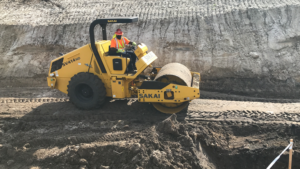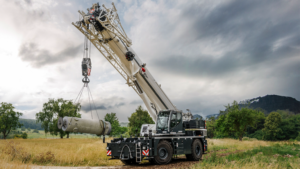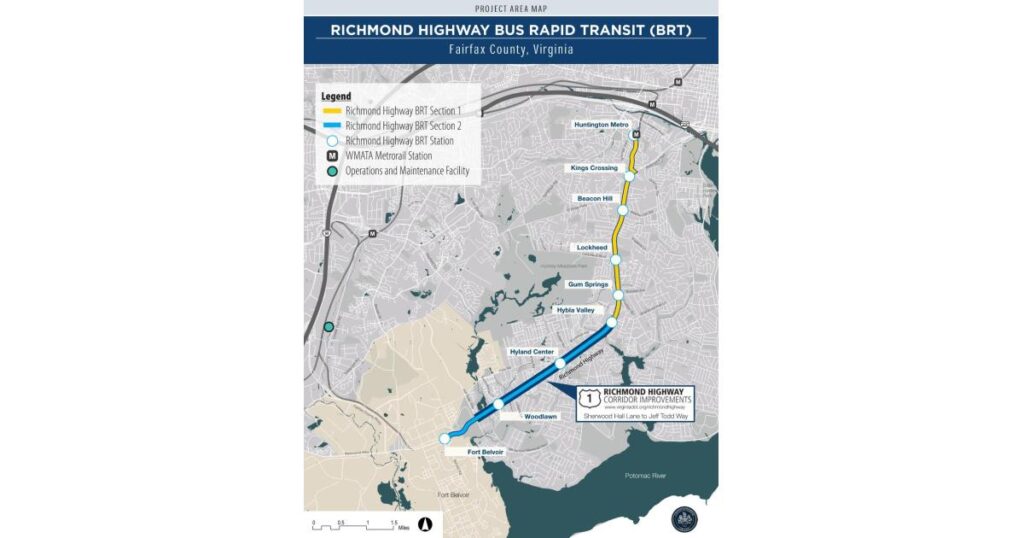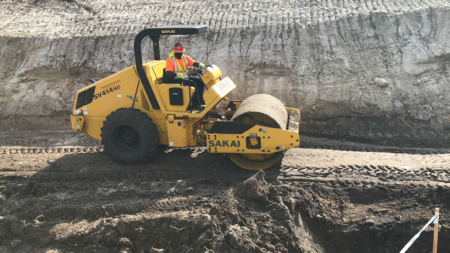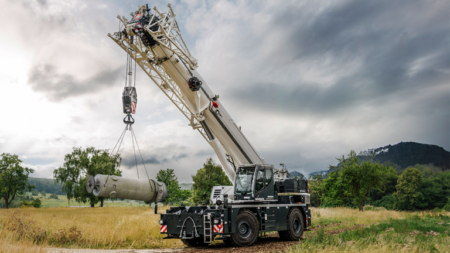fairfaxcounty.gov photo
Although construction will not begin until 2027 on Northern Virginia’s $937 million Richmond Highway Bus Rapid Transit (BRT) mega project, the effort is already making significant progress, Fairfax County officials said on Sept. 9.
The county’s Department of Transportation (FCDOT) received approval earlier this summer from the Federal Transit Administration (FTA) to commence the project’s engineering phase, marking a major design milestone that will lead directly to final design and construction.
The 7.4-mile BRT system, named “The One,” is intended to revitalize the Richmond Highway/U.S. Highway 1 corridor with a dedicated bus lane and mixed traffic.
Nine new transit station areas between the Huntington Metro station near Alexandria and the Fort Belvoir Military Reservation to the southwest also are included within the BRT project, along with pedestrian and bicycle facilities, and safety enhancements.
FCDOT’s aim is to improve transit frequency and reliability, as well as reduce traffic congestion and support economic growth in the southeastern portion of the county near the Potomac River.
The existing transit service in the corridor does not meet the needs of current or future residents, according to FCDOT, with challenges such as long travel times, infrequent service, and delays during rush hour. The new BRT system is expected to improve transit frequency, reliability, comfort and attractiveness.
“This milestone approval propels us towards a transformative era in Fairfax County’s transportation landscape,” said Jeffrey McKay, chair of the Fairfax County board of supervisors. “The Richmond Highway BRT project is not just about enhancing transit; it’s about fostering economic growth; improving the quality of life for our residents; and building a sustainable future. As we move into the engineering phase, we reaffirm our dedication to creating a modern, efficient, and reliable transit system that meets the evolving needs of our vibrant community.”
If all goes well with the construction, FCDOT plans to have the BRT fully operational by 2031.
The FTA approval aligns with Embark Richmond Highway, a Fairfax County project designed to improve the Richmond Highway area with better transportation options and economic growth. The county is working with the Virginia Department of Transportation (VDOT) to widen the highway to include more lanes and facilities for pedestrians and cyclists.
Endorsed by the county board of supervisors in 2015, the new BRT system was always seen as a key part of the plan. The improvements will support federal investments, including upgrades to Fort Belvoir.
Now, engineers working on the BRT mega project can begin detailed planning and design, FCDOT noted, as well as secure additional funding and prepare for its construction.
HRT Transit Stations to Support Area’s Development
Additionally, each of Fairfax County’s HRT transit stations will support compact, medium-density, mixed-use and pedestrian-oriented redevelopment efforts, also known as transit-oriented development (TOD), according to Holland & Knight, a law practice that has land-use teams focused on the Richmond Highway corridor.
The firm noted that the new urban nodes are designed to catalyze smart growth and economic development along Richmond Highway, transforming the auto-dominated highway into distinct new districts that are transit-oriented, pedestrian-friendly, and mixed-use. Additionally, the BRT will pave the way for a proposed future Metro extension from Huntington Station to Hybla Valley.
Given the nearly $1 billion future investment, the benefits of being designated as a commercial revitalization district, along with the current cost of land, makes the Richmond Highway corridor a prime area for redevelopment.
And, with the corridor already serving as a connection between Fort Belvoir, Fairfax County’s largest employer, and Amazon HQ2/Washington, D.C., both the highway and the new transit infrastructure are likely to further bolster additional improvements to the area.
During his time working for Fairfax County, Holland & Knight’s Washington D.C. and Northern Virginia Land Use Planner Anthony DeLorenzo served as the lead urban designer for the HRT project, where he oversaw the development of urban concepts that transformed current land use and transportation conditions into distinct multimodal transit-oriented districts.
Read the full article here

